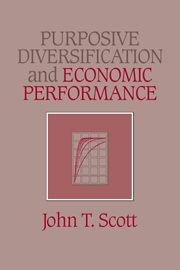Book contents
- Frontmatter
- Contents
- List of tables and figures
- Acknowledgements
- Introduction: An Overview
- Part I Static efficiency and the diversified firm
- Part II Firm and industry effects versus traditional models
- Part III Dynamic efficiency and the diversified firm
- Part IV Industrial policy
- 12 Diversification versus cooperation in R & D
- 13 From cooperative research to cooperative production
- 14 Damoclean taxation and innovation
- Afterword: Perspectives through time and across countries
- Notes
- References
- Index
12 - Diversification versus cooperation in R & D
from Part IV - Industrial policy
Published online by Cambridge University Press: 29 October 2009
- Frontmatter
- Contents
- List of tables and figures
- Acknowledgements
- Introduction: An Overview
- Part I Static efficiency and the diversified firm
- Part II Firm and industry effects versus traditional models
- Part III Dynamic efficiency and the diversified firm
- Part IV Industrial policy
- 12 Diversification versus cooperation in R & D
- 13 From cooperative research to cooperative production
- 14 Damoclean taxation and innovation
- Afterword: Perspectives through time and across countries
- Notes
- References
- Index
Summary
In this chapter, I shall use the ideas and findings from the preceding chapters to compare the diversification of R&D in the mid-1970s with the mid-1980s cooperative R&D that is protected by the National Cooperative Research Act of 1984 (NCRA, U.S. 98th Congress, October 1984). The evidence suggests that the effect of the law may well be to reduce innovative investment and cause investment to be further away from the socially optimal amount. Yet the NCRA model has been touted by business executives, economists, and policymakers as a way to improve U.S. industrial performance, and has become the basis for new law encouraging production joint ventures, as we shall see in Chapter 13.
I shall ask whether the initial response to the NCRA suggests that the act stimulated the types of activity envisioned by those supporting the new law. With the exception of a few examples, I use the first year and a half of data about the coooperative ventures registering under the new law because that seemed a large enough amount of information about initial reaction to gain some insight into whether the behavior reflected the concerns of the law's architects. I explore the issue in its historical context. For example, did the NCRA stimulate R&D in industries where the productivity slump hit hard, as the arguments made in support of the legislation suggested that it would? Of course, the desire to stimulate R&D in industries subject to a productivity slump may have been misguided.
Information
- Type
- Chapter
- Information
- Purposive Diversification and Economic Performance , pp. 169 - 186Publisher: Cambridge University PressPrint publication year: 1993
